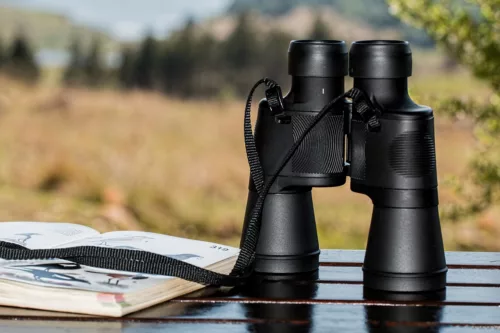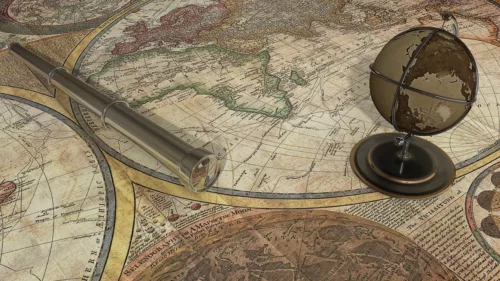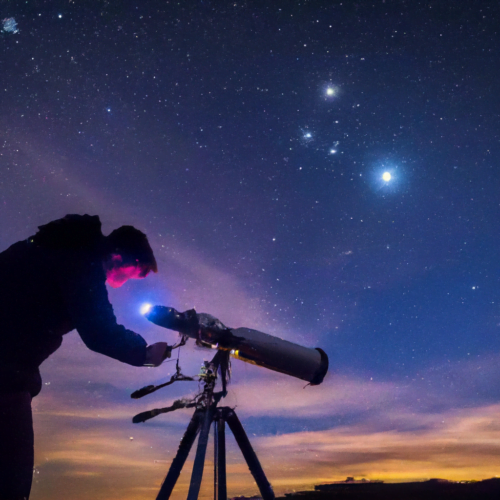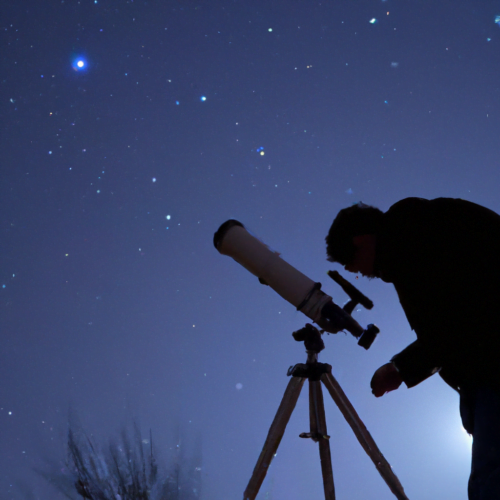So, you’ve developed a newfound interest in gazing at the stars and exploring the mysteries of the universe, but you’re not quite sure where to start. Well, fear not, because we’re here to guide you on your journey to becoming an avid celestial observer. Choosing the best telescope for beginners can be a daunting task, given the multitude of options available. However, we’re here to help you navigate through the complexities and find the perfect telescope to suit your needs. Whether you’re fascinated by planets, distant galaxies, or simply want to witness the beauty of a starry night, we’ve got you covered.

Table of Contents
Telescope Types
Reflecting Telescopes
Reflecting telescopes use mirrors to gather and focus light. These types of telescopes are known for their ability to capture more light, resulting in clearer and brighter images. They are often more cost-effective than refracting telescopes of the same aperture size. Reflecting telescopes are a popular choice among amateur astronomers due to their versatility in observing various celestial objects.
Refracting Telescopes
Refracting telescopes utilize lenses to gather and focus light. They are known for their crisp and detailed images, especially when observing the Moon and planets. Refracting telescopes are relatively low-maintenance and offer a wider field of view compared to reflecting telescopes. However, they tend to be more expensive for the same aperture size and may suffer from chromatic aberration, which can be mitigated through the use of apochromatic refractors.
Compound Telescopes
Compound telescopes, also known as catadioptric telescopes, combine features from both reflecting and refracting telescopes. They use a combination of mirrors and lenses to gather and focus light, providing a compact and versatile design. Compound telescopes are highly popular among astrophotographers due to their ability to capture detailed images of faint deep-sky objects. These telescopes often come with a higher price tag compared to other types.
Catadioptric Telescopes
Catadioptric telescopes, as the name suggests, employ a combination of lenses and mirrors to gather and focus light. They offer a unique optical design that allows for a more compact and portable telescope compared to other types. Catadioptric telescopes are known for their excellent image quality, particularly when observing planets and deep-sky objects. They are versatile and suitable for both visual observation and astrophotography.
Aperture
Importance of Aperture
When it comes to telescopes, aperture refers to the diameter of the main optical component, be it a mirror or a lens. It is one of the most crucial factors in determining a telescope’s light-gathering capability. The larger the aperture, the more light the telescope can collect, resulting in brighter and more detailed images. A larger aperture also allows for observing fainter objects in the night sky. Therefore, it is essential to consider the aperture size when purchasing a telescope, especially for celestial observation.
Recommended Aperture Size for Beginners
For beginners in celestial observation, a telescope with an aperture between 70mm and 130mm is recommended. Telescopes within this aperture range provide a good balance between portability and light-gathering capability. They are capable of providing satisfying views of the Moon, planets, and bright star clusters. As beginners become more experienced and observant, they may consider upgrading to larger aperture telescopes to explore deeper into the night sky.
Budget Considerations
While larger apertures offer better image quality and greater versatility, they often come with a higher price tag. It is important to consider the budget when deciding on the aperture size. Fortunately, there are plenty of entry-level telescopes available that provide decent image quality and performance without breaking the bank. It is advisable to prioritize both aperture size and overall quality when it comes to choosing a telescope within a specific budget range.
Mount Type
Altazimuth Mount
An altazimuth mount is a simple and intuitive mounting system that allows movement in vertical (altitude) and horizontal (azimuth) axes. It is easy to operate and provides a smooth and stable base for the telescope. Altazimuth mounts are commonly found in beginner telescopes, especially those designed for casual stargazing. However, they may lack the precision and tracking capability required for advanced astrophotography and long-exposure observations.
Equatorial Mount
Equatorial mounts are designed to align with the Earth’s rotation, allowing for tracking celestial objects as they move across the sky. They provide a more precise and steady platform for observing and astrophotography. Equatorial mounts are highly recommended for those interested in capturing long-exposure images of planets, galaxies, and nebulae. However, they may require a bit more practice and familiarity with the polar alignment process, which can take some time to master.
Motorized Mounts
Motorized mounts, also known as GoTo mounts, are equipped with motors and computerized systems that automate the process of locating celestial objects. With the help of a built-in database and accurate tracking, these mounts make it easier for beginners to find and observe specific targets in the night sky. Motorized mounts are particularly beneficial for astrophotography, as they eliminate the need for manual tracking. However, they tend to be more expensive compared to manual mounts and may require additional setup and calibration.
Portability
Telescope Size and Weight
When considering portability, the size and weight of the telescope play a significant role. A compact and lightweight telescope is easier to transport and set up. This is especially important for beginners who may want to bring their telescopes to different observation locations or store them in limited spaces. Telescope sizes can vary greatly, with some portable models designed to fit in backpacks or carry-on luggage, while others may require a dedicated tripod or mount for stability.
Transportation and Storage
It is essential to consider how easily a telescope can be transported and stored. Telescopes with collapsible or modular designs offer convenience in terms of portability. Some models may come with carrying cases or protective bags to ensure safe transportation. Additionally, telescopes with quick-release mounting systems or detachable optical tubes can make setup and disassembly more efficient. Proper storage, such as using padded cases or dedicated telescope cabinets, is also crucial to protect the equipment from dust, moisture, and accidental damage.

Accessories
Eyepieces
Eyepieces are essential accessories that determine the magnification and field of view of a telescope. They come in various focal lengths and can be easily switched to achieve different levels of magnification. It is recommended to have a range of eyepieces with different focal lengths to provide versatility in observing various celestial objects. High-quality eyepieces can greatly enhance the viewing experience by providing sharp and clear images.
Finderscopes
Finderscopes, also known as reflex sights or red dot finders, are used to assist in locating celestial objects. They provide a simple and straightforward way to align the telescope with the desired target. Finderscopes are particularly helpful for beginners who may have difficulty locating objects using the telescope’s main optical system. They are relatively inexpensive accessories that can greatly improve the efficiency and accuracy of locating celestial objects.
Tripods and Mounts
A stable and sturdy tripod or mount is crucial for providing a solid foundation for the telescope. Tripods and mounts come in various sizes, materials, and designs to cater to different telescopes. It is important to choose a tripod or mount that can support the weight of the telescope and provide smooth and precise movements. Adjustable legs, locking mechanisms, and built-in bubble levels are some features to consider when selecting a tripod or mount.
Filters
Filters for telescopes can enhance the visibility of specific details in celestial objects. They can help reduce glare from bright objects, increase contrast, and reveal specific wavelengths of light emitted by certain targets. Some common types of filters include moon filters, neutral density filters, and light pollution filters. Filters are valuable accessories for both visual observation and astrophotography, allowing astronomers to observe and capture finer details of celestial objects.
Astrophotography Attachments
For those interested in capturing stunning images of the night sky, astrophotography attachments are essential accessories. These may include camera adapters, focal reducers, and autoguiders. Camera adapters allow for the attachment of DSLR or mirrorless cameras to the telescope, while focal reducers help increase the field of view and decrease exposure times. Autoguiders assist in tracking celestial objects during long-exposure photography. Astrophotography attachments add versatility and expand the possibilities of capturing breathtaking images.
Budget Considerations
Entry-Level Price Range
Telescopes for beginners can range in price from around $100 to $500. Entry-level telescopes within this price range offer solid performance and decent image quality. They often come with basic accessories, such as eyepieces and finderscopes, to get new astronomers started in their celestial observation journey. While these telescopes may have limitations in terms of aperture size and advanced features, they provide a cost-effective way for beginners to explore the wonders of the night sky.
Additional Costs for Accessories
It is important to consider additional costs for essential accessories when budgeting for a telescope. Eyepieces, finderscopes, tripods, and filters are just a few examples of accessories that may need to be purchased separately. The cost of these accessories can vary depending on the quality and brand. It is advisable to allocate a portion of the budget specifically for accessories to enhance the overall observing experience and expand the capabilities of the telescope.

Brands and Models
Celestron
Celestron is a well-known and reputable brand in the astronomy community, offering a wide range of telescopes suitable for beginners and experienced astronomers alike. Their telescopes are known for their quality construction, excellent optics, and user-friendly features. Celestron provides a variety of models, including refractors, reflectors, compound telescopes, and motorized options, catering to different preferences and budgets.
Orion
Orion telescopes are highly regarded for their value and performance. They offer a range of telescopes that combine affordability with good optics, making them popular among beginners. Orion telescopes are known for their durability and ease of use, along with a selection of accessories to enhance the observing experience. Whether for visual observation or astrophotography, Orion provides a variety of models suitable for different levels of expertise.
Meade
Meade is a reputable brand that offers telescopes with advanced features and premium optics. They provide a range of telescopes for beginners, intermediate, and advanced users. Meade telescopes are known for their high-quality optics and sturdy construction. Their models often include motorized mounts, GoTo technology, and other advanced features that cater to astrophotographers and enthusiasts who want to explore the night sky in more detail.
Sky-Watcher
Sky-Watcher is a popular brand among amateur astronomers, offering telescopes known for their good value and performance. They provide a range of telescopes, from entry-level models to more advanced options for experienced users. Sky-Watcher telescopes often come with high-quality optics, durable construction, and innovative features, such as collapsible or modular designs. Whether for visual observation or astrophotography, Sky-Watcher has options to suit different needs and budgets.
Reviews and Recommendations
Best Telescopes for Beginners
When choosing the best telescope for beginners, several factors should be considered. These include ease of use, image quality, portability, and budget. Some highly recommended telescopes for beginners include the Celestron PowerSeeker series, the Orion StarBlast series, the Meade Infinity series, and the Sky-Watcher Heritage series. These models offer good entry-level performance, user-friendly features, and affordability to get new astronomers started on their celestial observation journey.
Pros and Cons
Each type of telescope and accessory has its own set of pros and cons. Reflecting telescopes offer cost-effectiveness and versatility, but may require more maintenance. Refracting telescopes provide detailed images but may be more expensive. Compound telescopes offer a compact design and versatility for astrophotography, but often come at a higher price. Tripods and mounts improve stability but may add bulk and weight. It is important to consider the pros and cons of each option to find the best fit for personal preferences and observing goals.
Customer Reviews
When purchasing a telescope, it is helpful to read customer reviews to gain insights into the product’s performance and reliability. Customer reviews can provide valuable information about image quality, ease of use, durability, and any potential issues or limitations. It is advisable to consider a range of customer reviews to get a balanced understanding of the product and make an informed decision.

Learning Resources
Astronomy Books and Guides
Astronomy books and guides are excellent resources for beginners to expand their knowledge and understanding of the night sky. They cover a wide range of topics, including celestial objects, observing techniques, and astrophotography tips. Some highly recommended books for beginners include “NightWatch” by Terence Dickinson, “Turn Left at Orion” by Guy Consolmagno and Dan M. Davis, and “The Backyard Astronomer’s Guide” by Terence Dickinson and Alan Dyer.
Online Communities and Forums
Online communities and forums provide platforms for astronomers to share their experiences, ask questions, and learn from others. Websites such as Cloudy Nights and Reddit’s r/telescopes and r/astrophotography communities are excellent resources for beginners to connect with fellow enthusiasts, seek advice, and gain valuable insights. These communities often provide a supportive and friendly environment, welcoming newcomers to the world of celestial observation.
Software and Apps
There are numerous software programs and mobile apps available to aid in celestial observation and astrophotography. Stellarium, SkySafari, and The Photographer’s Ephemeris are just a few examples of software and apps that provide star charts, astronomical information, and tools for planning observation sessions. These resources can greatly enhance the stargazing experience and assist in finding specific celestial objects accurately.
Conclusion
Factors to Consider
When choosing a telescope for beginners in celestial observation, several factors should be considered. The telescope type, aperture size, mount type, and portability are crucial aspects to evaluate. Additionally, the availability of accessories, budget considerations, and personal preferences play key roles in finding the best telescope to suit individual needs and goals.
Personal Preferences
It is important to take personal preferences into account when selecting a telescope. Consider the types of celestial objects you are most interested in observing, whether it be the Moon, planets, star clusters, or deep-sky objects. Also, consider the level of interest in astrophotography and the desire for ease of use or advanced features. By aligning personal preferences with the telescope’s capabilities, beginners can derive greater enjoyment and fulfillment from their celestial observation endeavors.
Starting Your Celestial Observation Journey
Selecting the best telescope for beginners in celestial observation is an exciting and important decision. By considering the various telescope types, aperture sizes, mount types, portability, accessories, budgets, and personal preferences, beginners can embark on their celestial observation journey with confidence. Remember to research, read customer reviews, and seek advice from experienced astronomers. With the right telescope and resources, the wonders of the night sky will unfold, revealing the beauty and mysteries of the universe. Happy stargazing!

